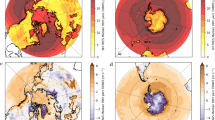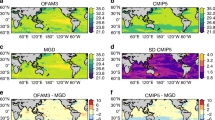Abstract
Extratropical cyclones are the main generators of the strong winds that cause large ocean waves in temperate regions of the world. The severity of the winds associated with these storms is poorly represented by the coarse resolution of current global climate models (GCMs), making it challenging to produce projections of the future climate of large waves. Wind data from GCMs can be downscaled in resolution using dynamical methods, resulting in a successful reproduction of the mean wave climate, but a suboptimal reproduction of the storm wave climate1. Projections of large wave occurrence can also be produced using statistical downscaling methods, although such methods have previously been applied only to three or less GCMs2,3, preventing a robust assessment of confidence in projections based on variation between models. Consequently, considerable uncertainty remains in projections of the future storm wave climate. Here we apply a statistical diagnostic of large wave occurrence in eastern Australia to 18 different GCMs, allowing model variations to be examined in greater detail than previously possible. Results are remarkably consistent between different GCMs, allowing anthropogenic influences to be clearly demonstrated, with fewer days with large waves expected to occur in eastern Australia due to increasing greenhouse gas concentrations.
This is a preview of subscription content, access via your institution
Access options
Subscribe to this journal
Receive 12 print issues and online access
$209.00 per year
only $17.42 per issue
Buy this article
- Purchase on Springer Link
- Instant access to full article PDF
Prices may be subject to local taxes which are calculated during checkout



Similar content being viewed by others
References
Hemer, M. A., McInnes, K. L. & Ranasinghe, R. Climate and variability bias adjustment of climate model-derived winds for a southeast Australian dynamical wave model. Ocean Dynam. 62, 87–104 (2012).
Wang, X. L. & Swail, V. R. Climate change signal and uncertainty in projections of ocean wave heights. Clim. Dynam. 26, 109–126 (2006).
Caires, S., Swail, V. R. & Wang, X. L. Projection and analysis of extreme wave climate. J. Clim. 19, 5581–5605 (2006).
Webb, E. L. et al. A global standard for monitoring coastal wetland vulnerability to accelerated sea-level rise. Nature Clim. Change 3, 458–465 (2013).
Hemer, M. A. & Griffin, D. A. The wave energy resource along Australia’s southern margin. J. Renew. Sust. Energy 2, 043108 (2010).
Short, A. D. & Trenaman, N. L. Wave climate of the Sydney region, an energetic and highly variable ocean wave regime. Aust. J. Mar. Freshwat. Res. 43, 765–791 (1992).
McInnes, K. L., Hubbert, G. D., Abbs, D. J. & Oliver, S. E. A numerical modelling study of coastal flooding. Met. Atmos. Phys. 80, 217–233 (2002).
England, P. R., Phillips, J., Waring, J. R., Symonds, G. & Babcock, R. Modelling wave-induced disturbance in highly biodiverse marine macroalgal communities: support for the intermediate disturbance hypothesis. Mar. Freshwat. Res. 59, 515–520 (2008).
Mills, G. A. et al. Centre for Australian Weather and Climate Research, Australia, CAWCR Technical Report 23 The Pasha Bulker east coast low of 8 June 2007. (Australian Weather and Climate Research, (2010).
Dowdy, A. J., Mills, G. A. & Timbal, B. Large-scale diagnostics of extratropical cyclogenesis in eastern Australia. Int. J. Climatol. 33, 2318–2327 (2013).
Dowdy, A. J., Mills, G. A., Timbal, B. & Wang, Y. Changes in the risk of extratropical cyclones in eastern Australia. J. Clim. 26, 1403–1417 (2013).
Dee, D. P. et al. The ERA-Interim reanalysis: Configuration and performance of the data assimilation system. Q. J. R. Meteorol. Soc. 137, 553–597 (2011).
Kulmar, M., Lord, D. & Sanderson, B. in Coasts and Ports: Coastal Living—Living Coast; Australasian Conference 2005; Proceedings (eds Townsend, M. R. & Walker, D.) Future Directions for Wave Data Collection in New South Wales. 167–172 (Institution of Engineers, 2005).
Speer, M. S., Wiles, P. & Pepler, A. Low pressure systems off the New South Wales coast and associated hazardous weather: Establishment of a database. Aust. Meteorol. Oceanogr. J. 58, 29–39 (2009).
Dowdy, A. J. et al. Tropical cyclone climatology of the South Pacific Ocean and its relationship to the El Niño-Southern Oscillation. J. Clim. 25, 6108–6122 (2012).
Dowdy, A. J. & Kuleshov, Y. An analysis of tropical cyclone occurrence in the Southern Hemisphere derived from a new satellite-era dataset. Int. J. Remote Sens. 23, 7382–7397 (2012).
Taylor, K. E., Stouffer, R. J. & Meehl, G. A. An overview of CMIP5 and the experiment design. Bull. Am. Meteorol. Soc. 93, 485–498 (2012).
Van Vuuren, D. P. et al. RCP2.6: Exploring the possibility to keep global mean temperature change below 2 degrees. Climatic Change 109, 5–31 (2011).
Izaguirre, C. et al. Exploring the interannual variability of extreme wave climate in the northeast Atlantic Ocean. Ocean Model. 59–60, 31–40 (2012).
Wang, X. L., Feng, Y. & Swail, V. R. North Atlantic wave height trends as reconstructed from the 20th century reanalysis. Geophys. Res. Lett. 39, L18075 (2012).
Hemer, M. A., Fan, Y., Mori, N., Semedo, A. & Wang, X. L. Projected changes in wave climate from a multi-model ensemble. Nature Clim. Change 3, 471–476 (2013).
Alexander, L., Wang, X., Wan, H. & Trewin, B. Significant decline in storminess over south-east Australia since the late 19th century. Aust. Meteorol. Oceanogr. J. 61, 23–30 (2011).
Meehl, G. et al. The WCRP CMIP3 multi-model dataset: A new era in climate change research. Bull. Am. Meteorol. Soc. 88, 1383–1394 (2007).
Hemer, M. A., McInnes, K. L. & Ranasinghe, R. Projections of climate change-driven variations in the offshore wave climate off south eastern Australia. Int. J. Climatol. 33, 1615–1632 (2012).
McInnes, K. L., Erwin, T. A. & Bathols, J. M. Global climate model projected changes in 10 m wind speed and direction due to anthropogenic climate change. Atmos. Sci. Lett. 12, 325–333 (2011).
Campins, J., Jansà, A. & Genovés, A. Three-dimensional structure of western Mediterranean cyclones. Int. J. Climatol. 26, 323–343 (2006).
Lim, E-P. & Simmonds, I. Southern Hemisphere winter extratropical cyclone characteristics and vertical organization observed with the ERA-40 data in 1979–2001. J. Clim. 20, 2675–2690 (2007).
Freitas, A. C. V. & Rao, V. B. Global changes in propagation of stationary waves in a warming scenario. Q. J. R. Meteorol. Soc. doi: 10.1002/qj.2151 (2013).
Grose, M. R., Pook, M. J., McIntosh, P. C., Risbey, J. S. & Bindoff, N. L. The simulation of cutoff lows in a regional climate model: Reliability and future trends. Clim. Dynam. 39, 445–459 (2012).
Acknowledgements
This study was financially supported by the Australian Climate Change Science Program (ACCSP) project grant, The Influence of Climate Change on East Coast Lows. The authors would like to thank M. Hemer from CSIRO and R. Colman from the Australian Bureau of Meteorology for providing comments on an initial draft of this manuscript.
Author information
Authors and Affiliations
Contributions
A.J.D. conceived the study and wrote the paper. Analysis was carried out by A.J.D. and Y.W. The manuscript was discussed and revised by all authors. All figures were produced by A.J.D., except Fig. 3 produced by A.J.D. and Y.W.
Corresponding author
Ethics declarations
Competing interests
The authors declare no competing financial interests.
Supplementary information
Rights and permissions
About this article
Cite this article
Dowdy, A., Mills, G., Timbal, B. et al. Fewer large waves projected for eastern Australia due to decreasing storminess. Nature Clim Change 4, 283–286 (2014). https://doi.org/10.1038/nclimate2142
Received:
Accepted:
Published:
Issue Date:
DOI: https://doi.org/10.1038/nclimate2142
This article is cited by
-
Wind-wave climate changes and their impacts
Nature Reviews Earth & Environment (2024)
-
A global ensemble of ocean wave climate statistics from contemporary wave reanalysis and hindcasts
Scientific Data (2022)
-
Review of Australian east coast low pressure systems and associated extremes
Climate Dynamics (2019)
-
Long-term changes in southern Australian anticyclones and their impacts
Climate Dynamics (2019)
-
Future wind and wave climate projections in the Indian Ocean based on a super-high-resolution MRI-AGCM3.2S model projection
Climate Dynamics (2019)



